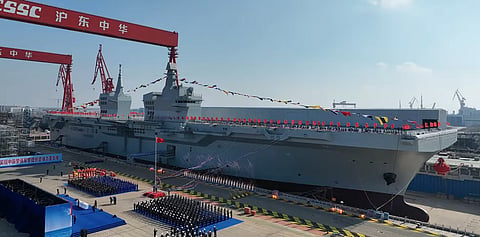

China began sea trials on Friday for its new Type 076 amphibious assault ship, marking a major milestone in naval development as the world’s first amphibious assault ship equipped with an electromagnetic aircraft launch system (EMALS). The lead vessel in the class, the PLA Navy’s Sichuan, departed from the Hudong-Zhonghua Shipyard in Shanghai to begin what is expected to be several months of testing before entering full service by late 2026 or early 2027.
The Sichuan was officially launched and named in December of last year, placing the timeframe from keel-laying to sea trials at just under eleven months—an indicator of the accelerating pace at which China continues to expand and modernize its naval fleet. Displacing more than 44,000 tons, the Type 076 is significantly larger than both earlier Chinese amphibious ships and the U.S. Navy’s America-class vessels.
A second hull is already reported to be under construction at the same shipyard, and analysts estimate that China could field between four and six Type 076 ships by 2030. Each vessel is expected to carry more than 1,000 Marines, amphibious assault vehicles, and a mixed air wing of 30 to 40 aircraft, including helicopters, drones, and fixed-wing fighters. The EMALS system, previously introduced on China’s new Fujian aircraft carrier, will allow the Type 076 to launch heavier aircraft with greater efficiency, increasing its capacity for long-range strike and surveillance missions.
The expansion of China’s amphibious capabilities comes during heightened tensions in both the Taiwan Strait and the South China Sea. Taipei has accelerated defense spending and military preparations, while Beijing continues to accuse the island’s government of promoting separatism. Regional militaries and Western defense analysts view the Type 076 as a potentially significant asset in any future conflict scenario involving Taiwan or contested maritime territories.
China now fields the world’s largest navy by number of hulls, with more than 370 vessels, compared to fewer than 300 currently active in the U.S. Navy. Analysts note that China’s industrial capacity enables rapid expansion and sustained production in ways the United States cannot replicate while maintaining global commitments. This shift has raised concerns that Beijing may be achieving regional naval parity—or even overmatch—in the Western Pacific.